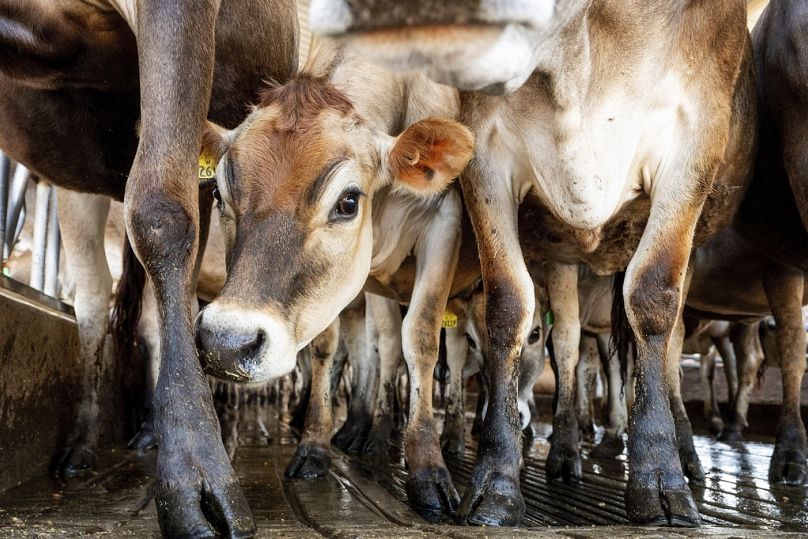Though it is the most well-known and second most abundant greenhouse gas, carbon dioxide is only one of the gases we need to tackle.
When sunlight reaches Earth, the surface of the planet absorbs some of this light’s energy and bounces it back as infrared waves which we feel as heat.
If they aren’t impeded these waves make their way up into the atmosphere and out into space. Atmospheric gases like oxygen and nitrogen don’t interfere with their journey. But others absorb energy at the right wavelength to soak up this infrared energy and re-emit it.
Around half of this energy goes out into space but the other half comes back to Earth as heat. This is what is known as the greenhouse gas effect, as greenhouse gases like carbon dioxide reduce the Earth’s ability to cool itself by radiating energy back into space. This is what causes global warming.
Though it is the most well-known and second most abundant greenhouse gas, carbon dioxide is only part of the equation. Many other gases are also regulated by the UN Framework Convention on Climate Change and the EU with requirements to monitor and report emissions.
The most notorious greenhouse gas is carbon dioxide (CO2)
Carbon dioxide is part of the natural cycle that keeps Earth liveable. It helps to act like a blanket, trapping heat to keep temperatures within a range that allows life to thrive. Too much of a good thing, however, upsets the delicately balanced proportion of gases.
Turbocharged by our burning of fossil fuels, carbon dioxide is now the single biggest contributor to the climate crisis.
The amount of CO2 in Earth’s atmosphere has increased by 50 per cent in less than 200 years. The insulating blanket has become too thick, overheating the Earth. And it is still rising at an alarming rate.
Though other gases have a much more potent heat-trapping ability per molecule, they simply aren’t as abundant in the atmosphere. CO2 is also pretty persistent. After it enters the atmosphere, 40 per cent will remain for 100 years, 20 per cent will stay for 1000 years, while the final 10 per cent will take 10,000 years to turn over.
The global warming potential (GWP) of any greenhouse gas is measured by comparing it to carbon dioxide, which is given a number of one. The bigger the GWP, the more that gas warms the Earth compared to CO2 over that time period.
Methane (CH4) emissions are a growing concern
This potent greenhouse gas is 30 times more potent than carbon dioxide. Scientists say it is responsible for around a third of the global heating we are experiencing today.
And world leaders are more than aware of the threat it poses. At COP26 in Glasgow in 2021, more than 100 countries pledged to cut methane emissions by 30 per cent by 2030.
So where does it come from? An estimated 60 per cent of all methane emissions result from human activity. The biggest sources are agriculture, fossil fuels and the decomposition of waste in landfills.
There are other cycles in motion too that boost emissions from natural sources. Global heating, for example, causes wetlands to emit more of their stored carbon in the form of methane.
As the second-largest source of emissions from human activity, the energy sector is a significant target for methane reduction pledges.
If all of the pledges currently made by countries and companies were implemented and achieved in full, on time, it would cut methane emissions from fossil fuels by 50 per cent by 2030. But, if you look at those with detailed policies or regulations planned or already in place, these would only cut methane from oil and gas by 20 per cent before the end of the decade.
In May this year, the EU adopted its first-ever rules to measure, report and verify emissions of this greenhouse gas. As of 2025, energy operators will face requirements to ensure mitigation measures such as detecting and repairing methane leaks as well as measuring emissions at the source.
Efforts to tackle nitrous oxide (N2O) emissions have been controversial
Nitrous oxide molecules can stay in the atmosphere for an average of 121 years before they are removed by some kind of sink or destroyed by chemical reactions. The warming potential of this gas is around 265 times that of carbon dioxide.
Though it is present in the atmosphere as part of the Earth’s natural nitrogen cycle, roughly 40 per cent of all N2O emissions come from human activities.
Three-quarters of that comes from agricultural soil management including the application of both synthetic and organic fertilisers. The rest comes from a mix of activities like land management (forest and grassland burning), transport and wastewater treatment.
Efforts to limit this greenhouse gas in the EU have proved controversial with farmers. In July, the EU approved a €105m subsidy scheme to encourage Dutch livestock farmers to move away from nature protection areas in a bid to tackle nitrogen emissions.
It came following widespread farmers’ protests that saw the Farmer-Citizen Movement (BBB) become part of a new right-wing coalition in the Netherlands.
Fluorinated gases come almost entirely from human activity
Fluorinated gasses or F-gases are man-made substances which contain fluorine. They have no substantial natural sources and come almost entirely from human-related activities.
Their GWPs range from thousands to tens of thousands, trapping substantially more heat than CO2. These powerful greenhouse gases have a range of everyday uses from refrigeration and heat pumps to fire protection, insulation and aerosol propellants.
They were initially developed as a replacement for ozone-depleting substances that are being phased out under an international agreement called the Montreal Protocol.
F-gases can also have a much longer lifespan in the atmosphere with some persisting for thousands of years. Many are only removed when they are destroyed by sunlight in the upper atmosphere.
There are four main categories of F-gases: hydrofluorocarbons, perfluorocarbons, sulphur hexafluoride and nitrogen trifluoride.
Hydrofluorocarbons (HFCs)
This is the largest subset of F-gases, making up over 90 per cent of all emissions. They are commonly used in air conditioning, refrigeration and building insulation.
These gases are a major concern because, though they currently only represent around 2 per cent of total greenhouse gases, their GWP is tens of thousands of times greater than carbon dioxide. The most abundant HFC warms the planet warms the planet 3,790 times as much as CO2 over a 20 year period. And HFC usage is growing at an average rate of 10 per cent each year.
These gases are mostly contained within equipment and leak out as a result of poor maintenance, wear or at the end of a product’s lifespan.
Perfluorocarbons (PFCs)
Though total emissions of PFCs are relatively small, they are extremely potent with a GWP nearly 10,000 times that of carbon dioxide.
They are produced as a byproduct of aluminium manufacturing and used in the electronics industry to make semiconductors - a material that can conduct electricity under specific conditions. These gases were also previously used to soundproof windows.
PFCs can also last in the atmosphere for thousands of years because there are no significant sinks for them.
Sulphur hexafluoride (SF6)
The GWP of SF6 is 23,500 making it the most potent greenhouse gas the Intergovernmental Panel on Climate Change has evaluated.
This colourless odourless gas is primarily used to insulate power lines. This has meant that our rapidly electrifying world has led to a rapid increase in atmospheric concentrations of SF6 this century.
New F-gas regulations in the EU have tightened up the timeframe for phasing out gases like SF6. But they don’t go as far as the initial proposals which sought to phase out this gas in all new switchgear - equipment for electrical transmission.
Scientists say the biggest source of SF6 is currently China which has offset reductions elsewhere in the world over the last 10 years.
Nitrogen trifluoride (NF3)
NF3 has a GWP 17,200 times that of carbon dioxide over a 100 year period. It is primarily released during the manufacturing process for electrical equipment like LCD panels, solar panels and chemical lasers.
The average lifespan of this gas in the atmosphere is about 550 years. And the rapid development of the consumer electronics market has led to huge growth in its use. But, of the NF3 used in manufacturing electronics, just 2 per cent is thought to escape into the atmosphere with the rest destroyed during the process.
The annual reporting of NF3 production, consumption, and waste emissions by large manufacturers has been required in many industrialised countries as a response to the observed atmospheric growth and the international Kyoto Protocol.
Water vapour doesn’t cause global warming on its own
Water vapour is the most abundant greenhouse gas on Earth. Present wherever there is measurable humidity it makes up around 80 per cent of the atmosphere’s total mass of greenhouse gas. It is responsible for around half of the overall greenhouse gas effect.
It doesn’t actually cause global warming itself, however, and is part of the vital process that traps heat in the Earth’s atmosphere to keep the planet liveable. Water vapour also has a short cycle, persisting for an average of 10 days before it becomes part of a weather event and falls back to the surface.
This means it can’t build up in the same way that a gas like carbon dioxide does.
But, as global warming gets worse, water vapour plays a role in the cycle that is warming the planet above what is normal.
Emissions like CO2 cause global air temperatures to rise. Warm air holds more moisture and also increases evaporation. For each degree Celsius temperatures increase, the laws of thermodynamics say water vapour in the atmosphere can increase by 7 per cent.
Rising water vapour concentrations in the atmosphere lead to further global warming. And so this cycle, known as stratospheric water vapour feedback, continues. It isn’t driving this change but is instead a consequence of the changes brought about by human-made greenhouse gases which then amplify their effects.













